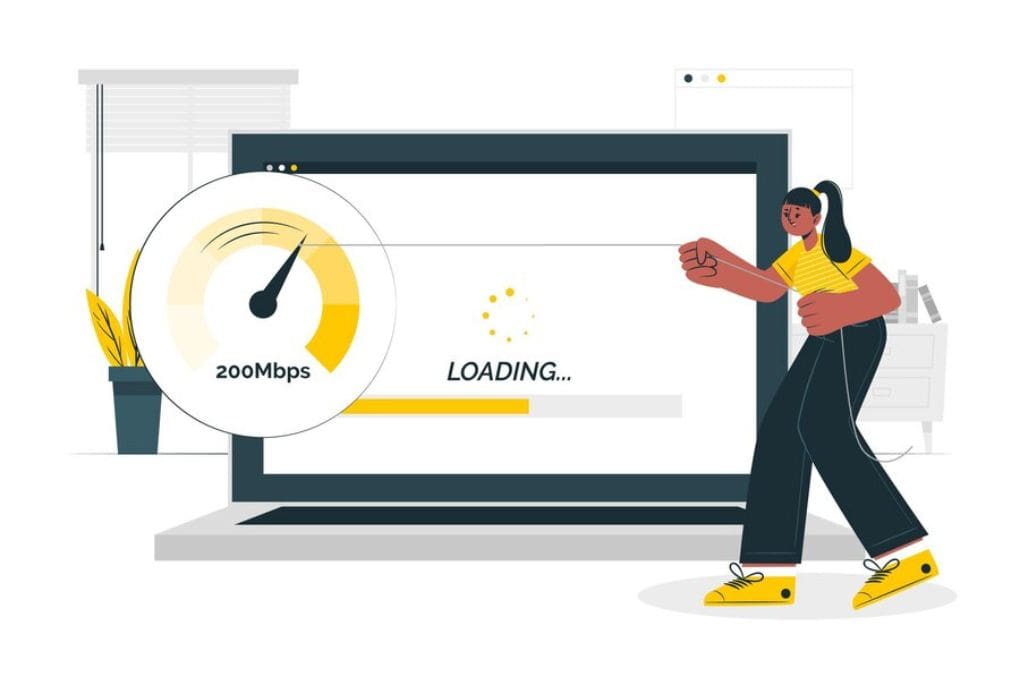In today’s fast-paced digital world, website loading speed plays a crucial role in determining user experience and overall success. With attention spans shrinking and competition intensifying, every second counts when it comes to engaging visitors and retaining their interest. One of the primary factors influencing loading speed is website design. In this blog post, we’ll explore actionable design strategies for Website Loading Speed Optimization and enhance user satisfaction.

Why is Website Loading Speed Optimization?
Website speed is crucial because it directly impacts user experience, engagement, and ultimately, the success of a website. In today’s fast-paced digital landscape, users expect instant access to information and seamless browsing experiences. A slow-loading website frustrates visitors, leading to increased bounce rates, decreased conversions, and loss of revenue opportunities. Moreover, search engines like Google prioritize fast-loading websites in their rankings, meaning slow speeds can negatively affect organic traffic and visibility. In essence, website speed is a fundamental aspect of user satisfaction, retention, and overall performance, making it imperative for businesses and individuals alike to prioritize optimization efforts.
Steps to take for website speed optimisation
Let’s delve deeper and have a look at the ways in which you can optimise the speed of your website while loading:
Optimize Images and Graphics:
High-resolution images and graphics are often the primary culprits behind slow-loading websites. By optimizing images through compression techniques without compromising quality, you can significantly reduce file sizes and enhance loading speed. Utilize image formats like JPEG or WebP and employ tools such as Adobe Photoshop or online compressors like TinyPNG to efficiently optimize visuals.
Implement Lazy Loading:
Lazy loading is a technique that defers the loading of non-critical resources, such as images or videos, until they are needed. This approach prioritizes the loading of essential content, allowing the initial page render to occur more quickly. Plugins and libraries like Lazy Load by WP Rocket or Intersection Observer API in JavaScript can automate the implementation of lazy loading, contributing to faster load times.
Minimize HTTP Requests:
Each element on a webpage, including images, scripts, and stylesheets, requires separate HTTP requests to load. Minimizing these requests by combining files, reducing the number of third-party scripts, and utilizing CSS sprites can significantly improve loading speed. Additionally, consider leveraging content delivery networks (CDNs) to distribute resources geographically and reduce server response times.
Opt for Responsive Design:
Responsive Website Speed Tactics ensures that websites adapt seamlessly to various devices and screen sizes, enhancing user experience across platforms. By eliminating the need for separate mobile versions or device-specific redirects, responsive design streamlines content delivery and reduces loading times. Employ frameworks like Bootstrap or CSS Grid Layout to create fluid and flexible layouts that prioritize performance.
Prioritize Content Above the Fold:
The content above the fold refers to the portion of a webpage visible without scrolling. Prioritizing essential content and critical resources in this area ensures that users receive meaningful information promptly. By minimizing the need for excessive scrolling and reducing the initial render time, this approach optimizes loading speed and enhances user engagement.
Optimize CSS and JavaScript:
Bloated CSS and JavaScript files can significantly impact website loading speed. Minify and concatenate these files to reduce their size and minimize the number of requests required for loading. Additionally, consider utilizing asynchronous loading for non-critical scripts to prevent them from blocking the rendering of the page content.
Enable Browser Caching:
Browser caching allows frequently accessed resources to be stored locally, reducing the need for repeated downloads upon subsequent visits. By setting appropriate cache expiration headers for static resources, you can enhance loading speed and improve overall website performance. Leverage tools like Apache’s mod_expires or WordPress plugins like W3 Total Cache to configure browser caching efficiently.
Evaluate Third-Party Integrations:
Third-party integrations, such as social media widgets or analytics trackers, can introduce additional overhead and slow down website loading speed. Conduct a thorough assessment of all integrations and prioritize those that provide tangible value to your audience. Minimize or eliminate unnecessary scripts and plugins to streamline the loading process and optimize performance.
Monitor and Analyze Performance:
Regularly monitor website performance using tools like Google PageSpeed Insights or GTmetrix to identify potential bottlenecks and areas for improvement. Analyze key performance metrics such as page load time, time to first byte (TTFB), and server response time to gain insights into loading speed optimization opportunities. Continuously iterate and refine your design strategies based on performance data to ensure ongoing improvements.
Conclusion
In conclusion, prioritizing Website Loading Speed Optimization through effective design strategies is essential for delivering optimal user experiences and achieving business objectives. By optimizing images, implementing lazy loading, minimizing HTTP requests, adopting responsive design, prioritizing content above the fold, optimizing CSS and JavaScript, enabling browser caching, evaluating third-party integrations, and monitoring performance, you can enhance loading speed and elevate the overall performance of your website. Embrace these design principles to create a faster, more responsive, and user-friendly web presence that resonates with your audience and drives success in the digital landscape.
Looking for the right experts to help you with your website’s speed? Connect with our team at SC Studios today and get a quote from our professionals.








